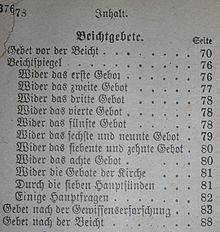Confessional mirror
A confession mirror is a sheet of paper or booklet that serves as an aid in examining one's conscience , especially in preparation for confession . Confession mirrors contain questions about different areas of life that are used for self-examination and as a memory aid. Sometimes they are with depictions of Jesus Christ , the Virgin Mary , the patron or the repentant thief in woodcut provided. Confession mirrors are therefore important for the beginnings of woodcut art.
Historical confession mirrors are also an important indirect source of the history of mentality , since literary evidence of deviating moral or religious behavior usually fell victim to the index .
Catholic prayer books have been containing so-called “conscience mirrors” that have been used in preparation for confession since the 14th century.
Mirror of conscience in praise of God
The number of the praise of God from 1975 is given below
- Gl 61: first mirror of conscience (brief explanations of the ten commandments , see Catholic Adult Catechism, Volume 2)
- Eq. 62: general mirror of conscience
- Gl 63: third mirror of conscience (faith - hope - love)
- Eq 64: fourth mirror of conscience (life for others)
- For children and teenagers:
- Eq 65: confession of the children
- Gl 66: student confession
In the new praise of God from 2013 there is the "Aids for examining conscience":
- GL 598: Aids in examining conscience for children
- GL 599: Aids in examining conscience for young people and adults
- GL 600: Examination of conscience 1
- GL 601: Examination of Conscience 2: The 10 Commandments
Web links
Individual evidence
- ↑ Martin von Amberg. Preacher and inquisitor. In: Author's Lexicon . Volume VI, Col. 143 ff.
- ↑ Praise to God. Catholic prayer and hymn book. Edited by the bishops of Germany and Austria and the dioceses of Bozen-Brixen and Liège
